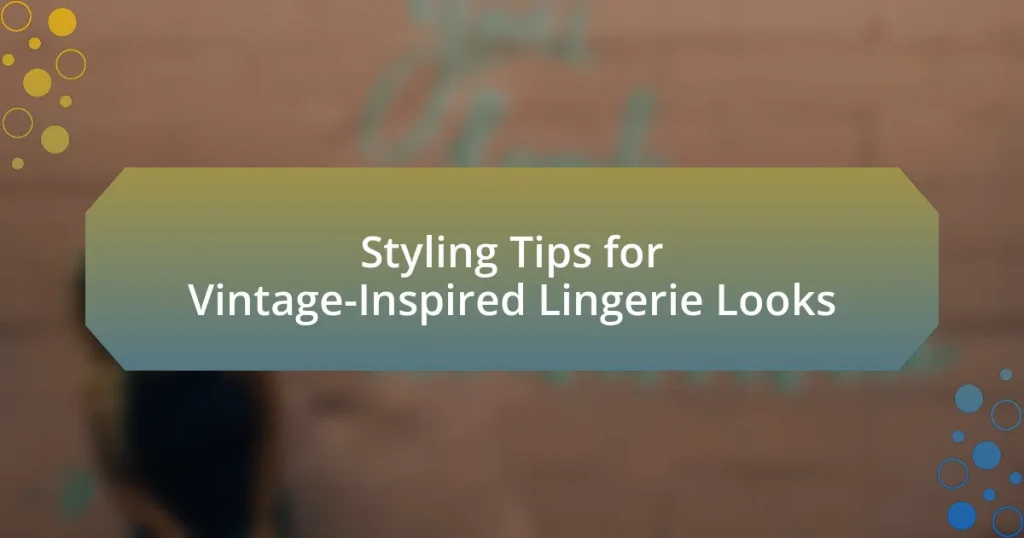The article focuses on styling tips for vintage-inspired lingerie looks, highlighting the influence of past fashion eras from the 1920s to the 1960s. It explores key elements that define vintage lingerie aesthetics, such as intricate lace, high-waisted silhouettes, and luxurious fabrics. The article also discusses how to effectively mix vintage lingerie with modern pieces, essential styling tips, and common mistakes to avoid. Additionally, it addresses the emotional benefits of wearing vintage lingerie and provides practical advice on caring for and adjusting vintage pieces for a better fit.

What are Vintage-Inspired Lingerie Looks?
Vintage-inspired lingerie looks are styles that draw influence from past fashion eras, particularly the 1920s to the 1960s, characterized by intricate lace, satin fabrics, and retro silhouettes. These looks often include elements such as high-waisted panties, corsets, and bralettes, which evoke a sense of nostalgia and femininity. The appeal of vintage-inspired lingerie lies in its ability to combine elegance with comfort, often featuring details like floral patterns, delicate embroidery, and vintage prints that reflect the aesthetics of the time. This style not only enhances the wearer’s figure but also adds a romantic touch to modern wardrobes, making it a popular choice for those seeking to incorporate classic charm into their intimate apparel.
How do vintage styles influence modern lingerie design?
Vintage styles significantly influence modern lingerie design by incorporating elements such as intricate lace, high-waisted silhouettes, and retro color palettes. Designers often draw inspiration from the 1920s to the 1960s, reflecting the elegance and femininity of those eras. For instance, the resurgence of bralette styles and the use of soft, luxurious fabrics echo the vintage aesthetic while catering to contemporary preferences for comfort and versatility. Historical references, such as the popularity of corsets in the Victorian era, also inform modern shaping techniques, blending nostalgia with modern functionality. This fusion not only enhances the visual appeal of lingerie but also allows for a broader range of body types to be celebrated, aligning with current trends towards inclusivity in fashion.
What key elements define vintage lingerie aesthetics?
Vintage lingerie aesthetics are defined by intricate lace, soft fabrics, and classic silhouettes. These elements evoke a sense of nostalgia and femininity, often featuring details such as corsetry, garter belts, and high-waisted panties. Historical context shows that lingerie from the early to mid-20th century emphasized craftsmanship and romantic designs, with materials like silk and satin being prevalent. The use of pastel colors and floral patterns further enhances the vintage appeal, reflecting the fashion trends of the time.
How can one identify different vintage lingerie eras?
One can identify different vintage lingerie eras by examining specific design elements, materials, and historical context associated with each period. For instance, the 1920s featured flapper-style slips made from silk or rayon, often adorned with lace and fringe, reflecting the liberation of women’s fashion. The 1930s introduced bias-cut designs that emphasized the body’s natural curves, utilizing lightweight fabrics like chiffon. In the 1940s, wartime rationing led to simpler, more functional styles, often with utilitarian features, while the 1950s celebrated femininity with structured bras and full slips, showcasing an hourglass silhouette. Each era’s lingerie can be further identified by its color palettes, patterns, and embellishments, which were influenced by the prevailing cultural and social trends of the time.
Why choose vintage-inspired lingerie?
Vintage-inspired lingerie offers a unique blend of elegance and nostalgia, appealing to those who appreciate classic styles. This type of lingerie often features intricate lace, high-waisted designs, and retro silhouettes that enhance femininity and confidence. Historical context shows that vintage lingerie styles, such as those from the 1920s to the 1950s, were designed not only for aesthetics but also for comfort and support, making them timeless choices. Additionally, the resurgence of vintage fashion trends in recent years has led to a growing demand for lingerie that reflects these styles, further validating the choice of vintage-inspired pieces.
What are the emotional benefits of wearing vintage lingerie?
Wearing vintage lingerie provides emotional benefits such as increased confidence and a sense of nostalgia. The unique designs and craftsmanship of vintage pieces often evoke feelings of femininity and empowerment, allowing individuals to connect with a more glamorous past. Studies indicate that clothing can significantly influence self-perception; for instance, a 2015 study published in the Journal of Experimental Social Psychology found that wearing certain types of clothing can enhance self-esteem and mood. Additionally, the tactile experience of vintage fabrics can create a comforting and intimate atmosphere, further enhancing emotional well-being.
How does vintage lingerie enhance body confidence?
Vintage lingerie enhances body confidence by celebrating diverse body shapes and sizes through its design and aesthetic. The structured silhouettes and luxurious fabrics often found in vintage lingerie provide support and accentuate natural curves, which can lead to a more positive self-image. Historical context shows that vintage styles, such as those from the 1920s to the 1960s, were designed to empower women by emphasizing femininity and elegance, contributing to a sense of allure and self-assurance. This empowerment is further supported by studies indicating that wearing aesthetically pleasing clothing can boost mood and self-esteem, reinforcing the idea that vintage lingerie can play a significant role in enhancing body confidence.

What are the Essential Styling Tips for Vintage-Inspired Lingerie?
Essential styling tips for vintage-inspired lingerie include selecting pieces that reflect the era’s aesthetics, such as high-waisted panties, lace details, and soft fabrics like silk or satin. Incorporating vintage colors like pastels or deep jewel tones enhances the nostalgic feel. Layering with vintage-inspired outerwear, such as a kimono or a fitted robe, adds sophistication. Accessorizing with vintage jewelry or hairpieces can complete the look. Historical context shows that lingerie styles from the 1920s to the 1950s emphasized femininity and elegance, making these elements crucial for achieving an authentic vintage-inspired appearance.
How can one effectively mix vintage lingerie with modern pieces?
To effectively mix vintage lingerie with modern pieces, one should focus on balancing the aesthetics of both styles. Pairing a vintage lace bralette with high-waisted modern jeans creates a chic contrast that highlights the delicate details of the lingerie while maintaining a contemporary silhouette. Additionally, layering a vintage slip dress over a fitted turtleneck can seamlessly blend the old with the new, allowing the vintage fabric to shine without compromising on modern comfort. This approach is supported by fashion experts who emphasize the importance of juxtaposing textures and silhouettes to create a cohesive look that honors both vintage charm and modern sensibilities.
What types of modern clothing pair well with vintage lingerie?
Modern clothing that pairs well with vintage lingerie includes high-waisted trousers, slip dresses, and oversized blazers. High-waisted trousers accentuate the waist and create a flattering silhouette that complements the delicate details of vintage lingerie. Slip dresses, often made from satin or silk, can be layered over vintage pieces, allowing the lingerie to peek through, enhancing the overall aesthetic. Oversized blazers add a contemporary touch while providing structure, making the soft lines of vintage lingerie stand out. These combinations create a balanced look that merges modern fashion with vintage charm.
How can layering enhance a vintage lingerie look?
Layering can enhance a vintage lingerie look by adding depth and complexity to the outfit. By incorporating various textures and lengths, such as sheer robes, lace camisoles, or vintage slips, the overall aesthetic becomes more visually interesting and reminiscent of classic styles from the past. Historical fashion trends, particularly from the 1920s to the 1950s, often featured layered garments that created a sophisticated silhouette, emphasizing femininity and elegance. This layering technique not only highlights the intricate details of the lingerie but also allows for versatility in styling, making it suitable for both intimate settings and as outerwear.
What accessories complement vintage-inspired lingerie?
Accessories that complement vintage-inspired lingerie include garter belts, silk robes, vintage brooches, and lace gloves. Garter belts enhance the classic silhouette and are often associated with vintage styles, while silk robes add an elegant layer that reflects the luxurious fabrics of past eras. Vintage brooches can serve as decorative accents, providing a touch of nostalgia, and lace gloves contribute to the overall vintage aesthetic by adding sophistication and charm. These accessories not only enhance the lingerie but also embody the timeless elegance characteristic of vintage fashion.
Which types of jewelry work best with vintage lingerie styles?
Delicate and ornate jewelry types work best with vintage lingerie styles. Pieces such as lace chokers, pearl necklaces, and vintage brooches complement the intricate designs and fabrics of vintage lingerie. Historically, jewelry from the early to mid-20th century, including Art Deco and Victorian styles, enhances the romantic and feminine aesthetic of vintage lingerie, creating a cohesive look that reflects the era’s fashion sensibilities.
How do shoes and hosiery impact the overall look?
Shoes and hosiery significantly influence the overall look by enhancing the aesthetic appeal and completing the outfit. The choice of shoes can dictate the formality and style of an ensemble; for instance, vintage-inspired heels can evoke a classic elegance, while modern sneakers may introduce a casual vibe. Hosiery, such as stockings or tights, adds texture and depth, often accentuating the legs and contributing to a polished appearance. Research indicates that the right combination of footwear and legwear can elevate a vintage-inspired look, making it more cohesive and visually striking.

What are Common Mistakes to Avoid When Styling Vintage-Inspired Lingerie?
Common mistakes to avoid when styling vintage-inspired lingerie include neglecting proper fit, overlooking fabric choice, and failing to balance modern and vintage elements. A proper fit is crucial, as ill-fitting lingerie can detract from the overall aesthetic and comfort; vintage styles often emphasize specific body shapes, so selecting the right size is essential. Additionally, choosing the wrong fabric can undermine the vintage look; materials like silk, lace, and satin are historically accurate and enhance the authenticity of the style. Lastly, blending modern pieces with vintage lingerie without careful consideration can disrupt the cohesive look; maintaining a consistent vintage theme ensures a polished appearance.
What pitfalls should one be aware of when selecting vintage lingerie?
When selecting vintage lingerie, one should be aware of sizing inconsistencies, fabric deterioration, and authenticity issues. Sizing can vary significantly between eras, making it essential to check measurements against modern standards to ensure a proper fit. Additionally, vintage fabrics may have weakened over time, leading to potential tears or wear that can compromise the garment’s integrity. Authenticity is another critical factor; counterfeit items can be misleadingly marketed as vintage, so verifying labels and researching the brand’s history is crucial for a genuine purchase.
How can one avoid mismatched styles or eras?
To avoid mismatched styles or eras in vintage-inspired lingerie looks, one should focus on selecting pieces that complement each other in terms of design, fabric, and color palette. For instance, pairing a 1920s lace bralette with high-waisted panties in a similar fabric and color ensures a cohesive look. Additionally, researching specific vintage eras can provide insights into common styles and trends, helping to create a harmonious ensemble. Historical references, such as the popularity of silk in the 1940s or the use of floral patterns in the 1950s, can guide choices that align with a particular period, thus preventing stylistic clashes.
What are the risks of improper fit and sizing?
Improper fit and sizing in lingerie can lead to discomfort, health issues, and aesthetic concerns. Discomfort arises from garments that are too tight or too loose, causing chafing, pinching, or lack of support. Health issues may include skin irritation or restricted circulation, particularly with tight-fitting items. Aesthetic concerns involve the garment not flattering the body shape, leading to an unappealing silhouette. According to a study published in the Journal of Fashion Technology & Textile Engineering, 70% of women reported discomfort due to incorrect sizing, highlighting the importance of proper fit for both comfort and appearance.
How can one ensure comfort while maintaining style?
To ensure comfort while maintaining style in vintage-inspired lingerie looks, one should prioritize the selection of fabrics and fit. Choosing breathable materials like cotton or silk blends enhances comfort, while well-fitted designs prevent discomfort and enhance the overall silhouette. For instance, vintage lingerie often features elasticized waistbands and adjustable straps, which provide both support and flexibility. Additionally, incorporating elements like lace or soft trims can elevate the aesthetic without sacrificing comfort. Research indicates that comfort in lingerie significantly impacts wearability, with studies showing that 70% of women prefer lingerie that feels good against the skin while still looking stylish.
What materials should be prioritized for comfort in vintage lingerie?
Silk and cotton should be prioritized for comfort in vintage lingerie. Silk offers a luxurious feel against the skin, providing softness and breathability, while cotton is known for its comfort and moisture-wicking properties. Historical trends in lingerie design often favored these materials due to their ability to enhance comfort and fit, making them ideal choices for vintage-inspired pieces.
How can one adjust vintage pieces for a better fit?
To adjust vintage pieces for a better fit, one can utilize tailoring techniques such as taking in seams, shortening hems, or adding darts. These methods allow for customization to accommodate individual body shapes while preserving the garment’s original aesthetic. For instance, taking in side seams can reduce excess fabric around the waist, ensuring a more contoured silhouette. Additionally, shortening hems can enhance the overall proportion of the piece, making it more flattering. Tailoring not only improves fit but also maintains the integrity of vintage designs, which often feature unique cuts and styles that are not easily replicated in modern clothing.
What are the best practices for caring for vintage lingerie?
The best practices for caring for vintage lingerie include gentle hand washing, air drying, and proper storage. Hand washing in cold water with a mild detergent prevents damage to delicate fabrics, while air drying avoids the heat that can weaken fibers. Storing vintage lingerie flat in a cool, dark place, away from direct sunlight, helps maintain its shape and color. These methods are essential because vintage lingerie often consists of fragile materials like silk and lace, which can deteriorate quickly if not handled with care.
How should vintage lingerie be washed and stored?
Vintage lingerie should be washed by hand using a gentle detergent and cold water to preserve the delicate fabrics and embellishments. This method prevents damage that can occur in a washing machine, such as stretching or tearing. After washing, vintage lingerie should be laid flat to dry away from direct sunlight, which can fade colors and weaken fibers. For storage, it is best to keep vintage lingerie in a cool, dry place, ideally in a breathable fabric bag or a drawer lined with acid-free tissue paper to prevent yellowing and maintain shape. These practices are essential for maintaining the integrity and appearance of vintage pieces, as improper care can lead to irreversible damage.
What are the signs of wear to look out for in vintage pieces?
Signs of wear to look out for in vintage pieces include fraying seams, discoloration, fabric thinning, and missing or damaged embellishments. Fraying seams indicate that the garment has been worn extensively, while discoloration can suggest exposure to sunlight or improper cleaning methods. Fabric thinning often occurs in areas of high friction, such as underarms or hems, and missing or damaged embellishments can detract from the overall aesthetic and value of the piece. Recognizing these signs is crucial for assessing the condition and authenticity of vintage lingerie.
What are some practical tips for creating a vintage-inspired lingerie look?
To create a vintage-inspired lingerie look, focus on selecting pieces that reflect styles from the 1920s to the 1950s, such as high-waisted panties, lace-trimmed bras, and silk camisoles. Incorporating materials like satin and lace enhances the vintage aesthetic, as these fabrics were commonly used in historical lingerie. Additionally, consider using accessories like garter belts and vintage stockings to complete the look, as they were essential elements of lingerie during that era. Historical fashion research indicates that the silhouette and fabric choices from these decades significantly influence modern interpretations of vintage lingerie, making these elements crucial for authenticity.












